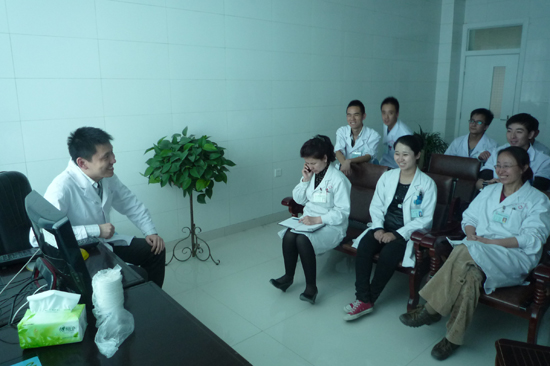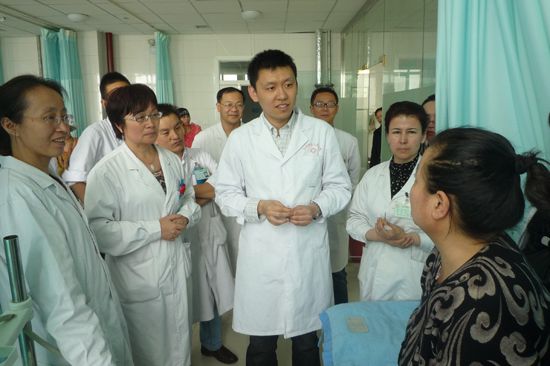the people's Hospital of Moyu County, where Wang Peng is located, is ready to set up a ward for the Department of traditional Chinese medicine in 2013, but the existing doctors are all low educated and have limited experience, and can not afford to work in the future ward, and continue to educate the future pillars of the Department of traditional Chinese medicine. A very important and meaningful work. Wang Peng is convenient to use the profound subject basis of Beijing Chinese Medicine Hospital, with "manual of traditional Chinese medicine" as the basic textbook, and combines the common diseases and multiple diseases here to compile the standard of diagnosis and treatment of common diseases in the first edition of traditional Chinese medicine. He used ordinary out-patient free time, from basic knowledge, combined with outpatient and ward cases, to improve the practical ability of Department of traditional Chinese medicine doctors and assess each month.

Wang Peng often use the free time in the outpatient department to explain the basic knowledge of traditional Chinese medicine for the young doctors in the Department of traditional Chinese medicine, and check them regularly. Photo source: the Chinese civilization network, Beijing Railway Station

every afternoon, Wang Peng took the doctor in the Department of traditional Chinese medicine to visit the ward to improve their practical ability. Photo source: the Chinese Civilization Network Beijing Railway Station
to open the situation for the work, and to provide more opportunities for the young doctors in the Department of traditional Chinese medicine to lay a good foundation for the future career. After consultation with the dean of the medical care, he led several young doctors in the Department of traditional Chinese medicine to take advantage of the afternoon. Room consultation. More than 2 months of ward consultation, successively for gynaecology, neurology, Department of Endocrinology, Department of Urology consultation of the patient 36, involving the internal medicine, surgery, gynecology of a variety of diseases. Over the past year, more than 200 patients were consulted, and more than 1000 patients were treated by acupuncture. At the same time of consultation, the young doctors in the Department of traditional Chinese medicine have had the opportunity to practice. Now, 3 young doctors can basically complete the acupuncture and moxibustion treatment of the ward consultation.

Wang Peng explained the "three way" method for medical staff. Photo source: the Chinese civilization network, Beijing Railway Station
as an important mission of medical aid, is to leave a medical team that can't take the local medical team and spread its professional and unit academic in the southern Xinjiang. After more than half a year's clinical application, the concept of he's acupuncture and moxibustion three - way method has already made a certain understanding of the doctors in the outpatient and ward, not only in the Department of traditional Chinese medicine, but also in the Department of Neurology, the Department of Neurosurgery, the rehabilitation department and other departments. In order to complete the mission of transmitting the three way of the three methods of acupuncture and moxibustion, it is necessary to play the task of transmitting the acupuncture and moxibustion in various aspects. In combination with the objective needs of acupuncture and moxibustion in the county hospital and the objective needs of the acupuncture and moxibustion rehabilitation, the He Puren acupuncture and moxibustion of the first Chinese master's acupuncture and moxibustion is held in Moyu County, which systematically explained the acupuncture and moxibustion of he's acupuncture and moxibustion. The "three links" method, especially the clinical application of fire needle therapy, focuses on the content of "three links" in the treatment of stroke. At the same time, he also invited Huang Haixia, director of Rehabilitation Department of the First Affiliated Hospital of Xinjiang Medical University, to give a lecture entitled "rehabilitation of cerebrovascular diseases". A total of more than 40 people participated in the study, including both doctors and nurses of our hospital, and medical staff from township hospitals and private hospitals. There were traditional Chinese medicine teachers who had been engaged in clinical work for many years, and Western medicine related to cerebrovascular diseases. After the lecture, we combined many questions and gained a lot from our major. This study not only radiated the academic and technical skills of the Chinese medicine masters to the South Xinjiang, but provided a "simple and efficient" traditional effective treatment method for the patients in the border areas, but also provided a platform for the Chinese medicine talents in the border areas to be able to solve the latest academic progress. Clinical techniques. At the end of the learning class, we were still reluctant to do so.